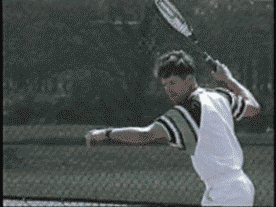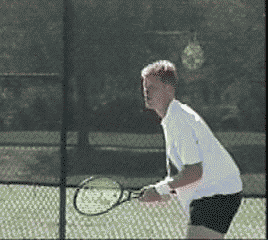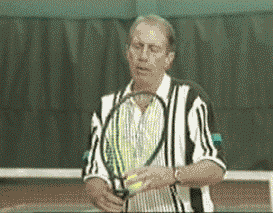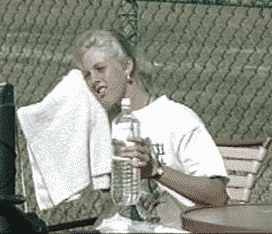
Breathing and the Mental Game
by Jim Loehr
Take a deep breath. Feel better? The breath of life. What could be
easier and more natural, right? You come into the world breathing deeply
from your gut, but, for most people, that doesn't last. In our fast-paced
society, with its ever-increasing levels of stress, good breathing habits
are actually rare.
|

Many players, even at high levels, restrict their breathing under
pressure. |
Most people breath with short, restricted breaths, instead of using the
deeper, slower abdominal breathing that facilitates relaxation and high
energy. This is true in life and it's true on the tennis court as well.
A crucial aspect to improving mental toughness and sustaining the ideal
performance state is developing better breathing habits on the court.
Our breathing is a window to our emotions. Our breathing patterns
fluctuate as our feelings change. Conversely, we can have a significant
effect on how we feel and how we perform by controlling the way we
breathe.
Proper breathing technique is a thread that runs through every aspect of
tennis, what happens during the points, and what happens in the vital time
between points as well.
It is central to staying relaxed, maintaining confidence and a sense of
fun, so that we fuel our performance from our positive emotions. In a
literal sense, the key to emotional control and creating and sustaining
our ideal performance state is breath control.
|

Breath control is central to fueling your tennis from positive
emotions. |
Breath Control
Let's look at how to develop breath control, both during actual play
and in the time between points.
Most people tend to hold their breath under stress. In tennis, surprising
numbers of players, including players at the top of professional tennis
are actually barely breathing during competitive play. At a time when your
body needs it most, there is a tendency to deprive it of the oxygen that
is central to good performance.
Restricting breathing disrupts the flow of the game. It leads to muscle
tension, short constricted strokes, poor movement and generally erratic
play. Players may unconsciously make errors or go for big shots just to
get the point over, so that they can get their breath again.
Holding your breath is actually a powerful way to stimulate the choking
response most players are so desperate to avoid. Developing a breathing
rhythm is essential to maintaining harmony and consistency in your play.
Start by observing how you breathe when you strike the ball. Your goal
should be to get your breathing perfectly synchronized with your hitting.
Exhale through your mouth at the contact point. The flow of air should be
aggressive and long.
If you are doing it correctly, you will naturally make the long sound of
“ah” as you hit. It will feel as if you are attacking the ball with your
breath.
To develop this breathing pattern, an auditory cue will make the learning
process much easier. As you strike the ball in practice, pronounce the
word “yes” at the contact point.
|

With proper exhalation, you attack the ball with your breath. |
If you have a long habit of holding your breath, it may take two to three
weeks of practice to get your breathing synchronized. As a result, you
will be more relaxed as you hit, since your muscles are naturally more
relaxed when you exhale.
The result will be a more relaxed and fluid style. Your rhythm will
improve. Your follow-throughs will be long and smooth. You will be more
aggressive naturally by attacking the ball with your breathing.
Note that exhaling at contact is not necessarily the same thing as
grunting. Many competitive players tend to grunt on contact. The grunt is
actually unnecessary and, in fact, can contribute to breath constriction.
Players who grunt often make a short, high pitched sound which actually
produces reduced, rather than expanded exhalation.
If you are a grunter, start paying special attention to your breathing.
Make sure that you are exhaling fully.
Using music can provide an additional dimension for the development of
good breath control during play. Many great competitors believe that music
actually facilitates the rhythm in tennis. Singing or humming to yourself
can help you get breathing in sync with your play.
This is particularly valuable for players who are overly self-critical or
analytical. Music can help to induce a neurological shift from the left
side of the brain, which is logical and sequential, to the right side
which is free flowing and spontaneous. No athlete can reach his full
potential without using both sides of the brain.
|

Between point breathing as important as breathing during points. |
Breathing correctly between points is as important as breathing correctly
during points. Deep breaths are crucial to relaxing and recovering from
the stress of playing points. They should be an inherent part of your
between point behavior.
As you are walking to the back of the court after the point, focus on your
breath. It should be long, full, and continuous. The more difficult or
strenuous the point, the more anxiety you are likely to feel about the
next point or the match situation, the more the breath should be full and
complete.
The breath should actually come from your lower abdomen and held deeply
from your stomach. It should expand first, then let your breath fill your
chest and lungs. Now, exhale in the same relaxed fashion.
At the end of the breath, pull your abdominal muscles in to force the last
of the air out. This is called abdominal or diaphragmatic breathing. If
you do not naturally breathe this deeply, you will want to practice it off
the court until it becomes very natural.
Remember that you have 25 seconds between points, so take your time. With
practice, you will sense when you have recovered your emotional and
physiological equilibrium through this relaxed breathing and are ready to
prepare for the next point.
As you step up to the line, take a final deep breath before you start the
point. This will keep your mind centered in the present, your focus on the
ball rather than the match situation, and help you play the points one at
a time.
The role of breathing is also critical in the time between games. On the
changeovers, you have 90 seconds. You should get in the habit of taking
all of it to recover and to sustain your mental toughness through the
course of a match. Sit down. Towel off. Drink water. And focus on your
breathing.
|

On the changeovers, towel off, drink water, and focus on your
breathing. |
Here is a special breath to help relax. Inhale slowly through your nose to the
count of four. Now, hold that breath for two seconds. Now exhale through
your mouth to a count of eight. Repeat this for the first 30 seconds of
the changeover.
The use of breathing techniques can also play a vital role in easing
pre-match tension. On match days, practice the relaxation breath.
Inhale through your nose to a count of four, hold for two counts, and then
exhale through your mouth to a count of eight. Practiced over time, this
technique can help relieve even the severest cases of pre-match nerves.
Breathing is essential for maintaining physical harmony in tennis. Breath
control gives you a powerful technique for establishing and also for
restoring your ideal performance state under a tense, competitive
pressure. Practice these techniques and watch how they can affect your
play and enjoyment of the game.
|
Want to read more of Jim Loehr's unique
prospective? Check out his other original articles in the TennisONE
Lesson Library.
|
Your comments are welcome. Let us know what you think
about this article by
emailing us here at TennisONE.
 Dr. James Loehr, CEO of LGE Performance Systems, is recognized as a
world pioneer in the field of sports psychology and mental toughness
training. Dr. James Loehr, CEO of LGE Performance Systems, is recognized as a
world pioneer in the field of sports psychology and mental toughness
training.
He has worked with dozens of elite athletes in Olympic and
professional sports, including Grand Slam champions such as Martina Navritilova and Jim Courier.
For more information about training
packages for tennis or for the corporate athlete, click here:
http://www.corporateathlete.com/index.html
 Pro Secrets of Mental Toughness Pro Secrets of Mental Toughness
In Pro Secrets of Mental Toughness, Jim Loehr, the world’s leading
sports psychologist, trains you to develop the same mental skills used
by the world’s top professional players.
Overcome choking, play your best tennis under pressure, become the
player you really want to be!
|






 Dr. James Loehr, CEO of LGE Performance Systems, is recognized as a
world pioneer in the field of sports psychology and mental toughness
training.
Dr. James Loehr, CEO of LGE Performance Systems, is recognized as a
world pioneer in the field of sports psychology and mental toughness
training.
 Pro Secrets of Mental Toughness
Pro Secrets of Mental Toughness